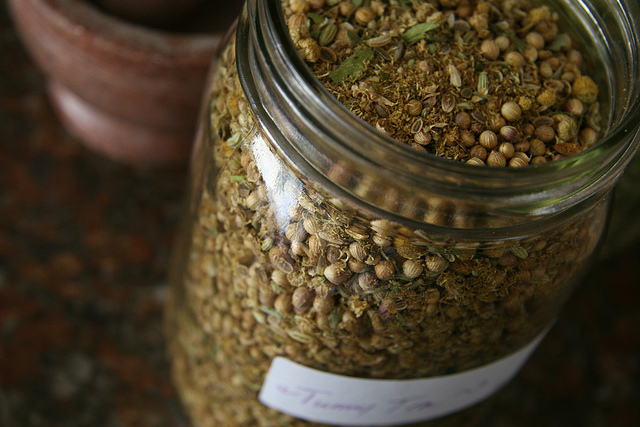

Plants have evolved over millions of years, developing chemical compounds which aide them in fending off bacteria, fungi and grazing animals. When consumed by humans, these chemically unique compounds can affect a variety of processes within our bodies. Many of the compounds created by different herbs are similar in structure and function to compounds which are essential to human physiology. As a result these herbal constituents can have profound physiological effects on the human body. This concept is not surprising if we consider that animals and humans have mutually co-evolved over millions of years1.
History
Herbal medicine is an ancient system of medicine which has been used by many civilizations throughout history. Egyptian medical texts2 dating back to the 17th and 16th centuries BC contained detailed information regarding anatomy, physiology and specific health conditions with corresponding herbal treatments. The oldest recovered Chinese herbal text, Huang Di Nei Jing (Yellow Emperor Classic), is dated between 500 BC – 200 AD. It details much of the fundamental principles of Traditional Chinese Medicine, including herbal medicines3. Also, the earliest known Indian (Ayurvedic) herbal medicine texts are dated between 500 BC – 500 AD4. In Europe herbal medicine gained popularity in the 1500-1600s, with many authors publishing extensive records5 of the medicinal uses of herbs.
Drugs From Plants
Many important, widely used, drugs have been isolated and/or modified from plant sources. An extract from the Pacific Yew tree is the starting material of a first line chemotherapy drug used in many types of cancer, Paclitaxel6. Also, the White Willow tree is the the starting material for one of the most commonly used drugs in the world, Aspirin7. Interestingly, White Willow was reportedly used by several ancient doctors, including Hippocrates8, for rheumatic pain. These two drugs, along with a large list of others, have been derived from plant sources.
Uses
Traditional herbal medicine was used to treat a wide variety of conditions, including pain, arthritis, weight loss, anxiety, depression, etc. Most modern day herbal research is based on testing traditional herbal uses and generally the research backs it up. Milk thistle9, for example, has traditionally been used as a liver-tonic and research has recently shown it to improve outcomes in chronic liver disease. Traditional treatments for migraine10, anxiety11, menopausal symptoms12 and the common cold13, among many others, have also been supported by modern research. An interesting area of new herbal research is in finding new medicines, including cancer treatments14.
Herbal medicine has many valid and useful applications, which when properly applied, can have profound results. Herbal medicine has been used for thousands of years across many civilizations and has more recently seen significant modern scientific validation. Due to the complex nature of herbal medicine and potential for interactions with medications it is best to consult with a practitioner trained in the proper use of herbs who can work with you to design an optimal treatment plan.
References
- Smallwood P. An Integrative Approach to the Study of Plant-Animal Interactions. Amer. Zool. 2001 41:807–809.
- Aboelsoud N. Herbal medicine in ancient Egypt. J. Med. Plants Res. Vol. 4 (2), pp. 082–086, 18 January 2010.
- Unschuld P. Medicine in China: A History of Ideas. Berkeley: University of California Press, 1985.
- Wujastyk D. The Roots of Ayurveda : selections from Sanskrit medical writings. London, New York: Penguin Books, 2003.
- Barlow H. Old English Herbals, 1525-1640. Proc R Soc Med. 1913; 6(Sect Hist Med): 108–149.
- Wall M, Wani M . Camptothecin and taxol: discovery to clinic–thirteenth Bruce F. Cain Memorial Award Lecture. Cancer Res. 1995 Feb 15;55(4):753-60.
- Miner J, Hoffhines A. The discovery of aspirin’s antithrombotic effects. Tex Heart Inst J. 2007;34(2):179-86.
- Vane J. The fight against rheumatism: from willow bark to COX-1 sparing drugs. J Physiol Pharmacol. 2000 Dec;51(4 Pt 1):573-86.
- Loguercio C, Festi D. Silybin and the liver: from basic research to clinical practice. World J Gastroenterol. 2011 May 14;17(18):2288-301.
- Ernst E, Pittler MH. The efficacy and safety of feverfew (Tanacetum parthenium L.): an update of a systematic review. Public Health Nutr. 2000 Dec;3(4A):509-14.
- Geier F, Konstantinowicz T. Kava treatment in patients with anxiety. Phytother Res. 2004 Apr;18(4):297-300.
- van Die M, Burger HG, Teede HJ, Bone KM. Vitex agnus-castus (Chaste-Tree/Berry) in the treatment of menopause-related complaints. J Altern Complement Med. 2009 Aug;15(8):853-62.
- Melchior J, Spasov AA, Ostrovskij OV, Bulanov AE, Wikman G. Double-blind, placebo-controlled pilot and phase III study of activity of standardized Andrographis paniculata Herba Nees extract fixed combination (Kan jang) in the treatment of uncomplicated upper-respiratory tract infection. Phytomedicine. 2000 Oct;7(5):341-50.
- Kienle GS, Kiene H. Integr Cancer Ther. Review article: Influence of Viscum album L (European mistletoe) extracts on quality of life in cancer patients: a systematic review of controlled clinical studies. 2010 Jun;9(2):142-57.


